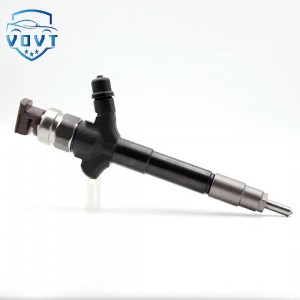High Quality Auto Parts Diesel Fuel Injector 095000-9680 Fuel Injector Engine Parts
Products Description
| Reference. Codes | 095000-9680 |
| Application | / |
| MOQ | 4PCS |
| Certification | ISO9001 |
| Place of Origin | China |
| Packaging | Neutral packing |
| Quality Control | 100% tested before shipment |
| Lead time | 7~15 working days |
| Payment | T/T, L/C, Western Union, Money Gram, Paypal, Ali pay, Wechat |
How does an engine's emissions control system work with the fuel injection system?
Cooperation between three-way catalytic converter and fuel injection system
Air-fuel ratio feedback control: To achieve the best purification effect of the three-way catalytic converter, the engine's air-fuel ratio needs to be close to the theoretical air-fuel ratio (for gasoline engines, it is generally 14.7:1). The oxygen sensor in the emission control system is installed in the exhaust pipe to monitor the oxygen content in the exhaust gas to determine whether the air-fuel ratio of the mixture is too rich or too lean. The oxygen sensor feeds back the signal to the engine control unit (ECU), and the ECU adjusts the injection amount of the fuel injection system based on this feedback signal. If the oxygen sensor detects that the oxygen content in the exhaust gas is too low, it means that the mixture is too rich, and the ECU will reduce the fuel injection amount; conversely, if the oxygen content is too high, it means that the mixture is too lean, and the ECU will increase the injection amount, so that the air-fuel ratio is always kept within the range where the three-way catalytic converter can work efficiently, effectively reducing the emission of pollutants such as carbon monoxide (CO), hydrocarbons (HC) and nitrogen oxides (NOx).
Temperature management: The working efficiency of the three-way catalytic converter is closely related to the temperature, and generally a certain temperature range is required to achieve the best performance. The fuel injection system can affect the exhaust temperature of the engine by adjusting the injection amount and combustion timing, thereby indirectly controlling the operating temperature of the three-way catalytic converter. For example, during cold start, the fuel injection system will appropriately increase the injection amount to quickly heat up the engine and allow the three-way catalytic converter to reach the operating temperature as soon as possible; under high load conditions, the injection amount and ignition advance angle will be adjusted as needed to prevent the three-way catalytic converter from being damaged due to excessive temperature, ensuring that it can purify the exhaust gas stably and efficiently.
Cooperation between the exhaust gas recirculation (EGR) system and the fuel injection system
Injection amount adjustment: The EGR system introduces part of the exhaust gas into the intake manifold, which is mixed with fresh air and then enters the combustion chamber. Since the exhaust gas contains a large amount of inert gases such as carbon dioxide, it will reduce the combustion speed and combustion temperature, thereby reducing the generation of NOx. However, the introduction of exhaust gas will change the composition and combustion characteristics of the mixture, so the fuel injection system needs to adjust the fuel injection amount accordingly according to the opening of the EGR valve and the amount of exhaust gas. Generally speaking, as the EGR rate increases, the fuel injection amount needs to be appropriately increased to ensure the power output and combustion stability of the engine.
Injection timing optimization: The operation of the EGR system will affect the state of the intake air and the combustion process. The fuel injection system needs to optimize the injection timing according to the working conditions of the EGR so that the fuel and the mixture containing the exhaust gas can be better mixed and burned. For example, when the EGR system is working, it may be necessary to advance the fuel injection timing to utilize the stirring effect of the intake vortex and the exhaust gas to make the fuel more evenly distributed in the mixture, improve the combustion efficiency, and reduce pollutant emissions.
Particulate filter (DPF) and fuel injection system coordination
Regeneration control: For diesel engines, the particulate filter is used to capture particulate matter in the exhaust. When the particulate matter in the DPF accumulates to a certain extent, a regeneration operation is required to burn the captured particulate matter and restore the filtering performance of the DPF. During the regeneration process, the fuel injection system will increase the exhaust temperature by injecting additional fuel in the exhaust pipe or combustion chamber, so that the particulate matter is oxidized and burned at high temperature. This additional fuel injection requires precise control of the injection amount and injection timing, which must ensure that sufficient heat can be provided to regenerate the particulate matter without causing engine performance degradation or other problems.
Fuel quality coordination: The fuel injection system will adjust some injection parameters according to the quality of the fuel used to adapt to the impact of different fuels on emissions. For example, for fuels with a high sulfur content, the injection volume and injection timing may be appropriately adjusted to reduce the generation of particulate matter and reduce the burden on the DPF. At the same time, some advanced fuel injection systems can also optimize the injection process according to the additive composition in the fuel, improve combustion efficiency, and further reduce emissions.
























